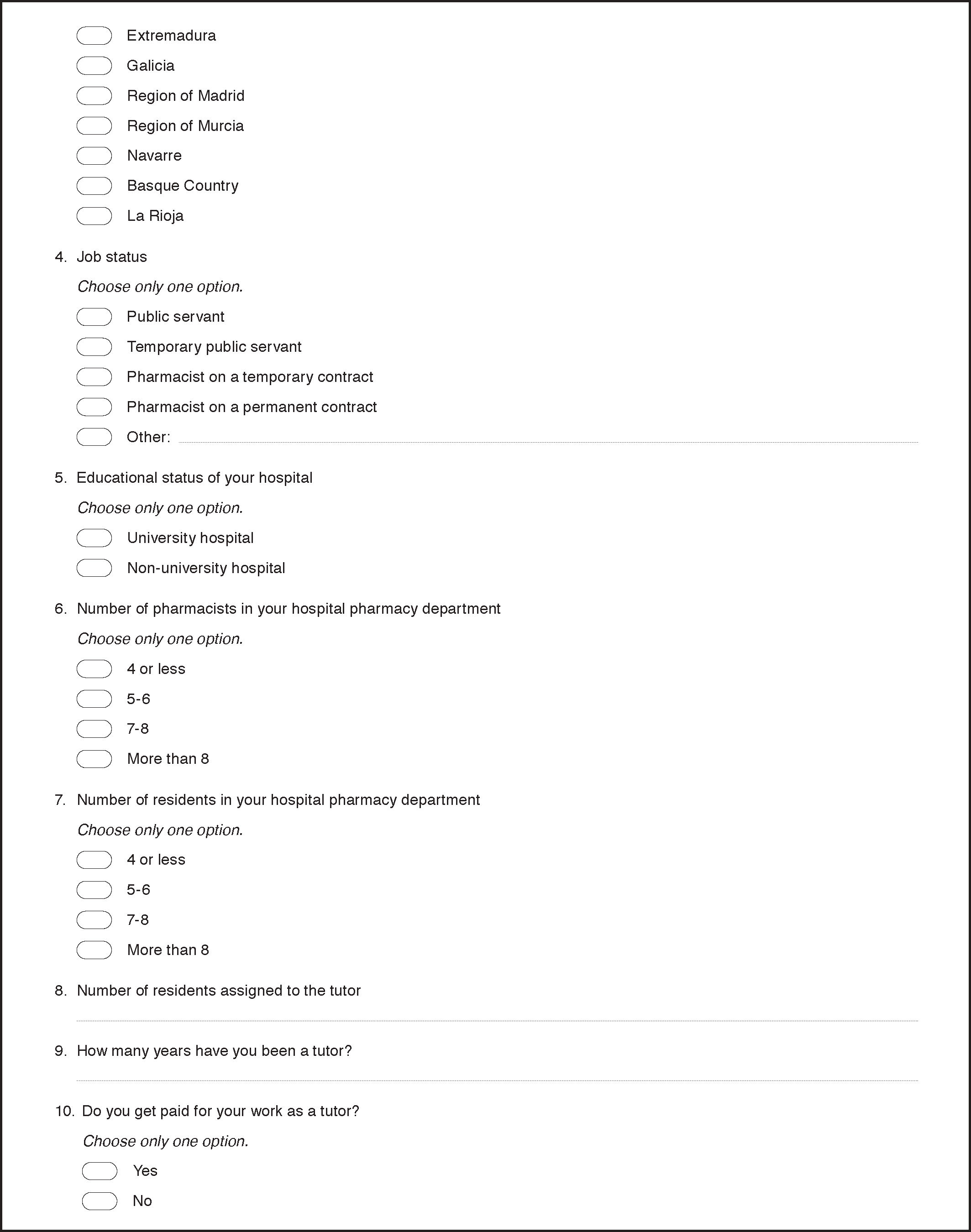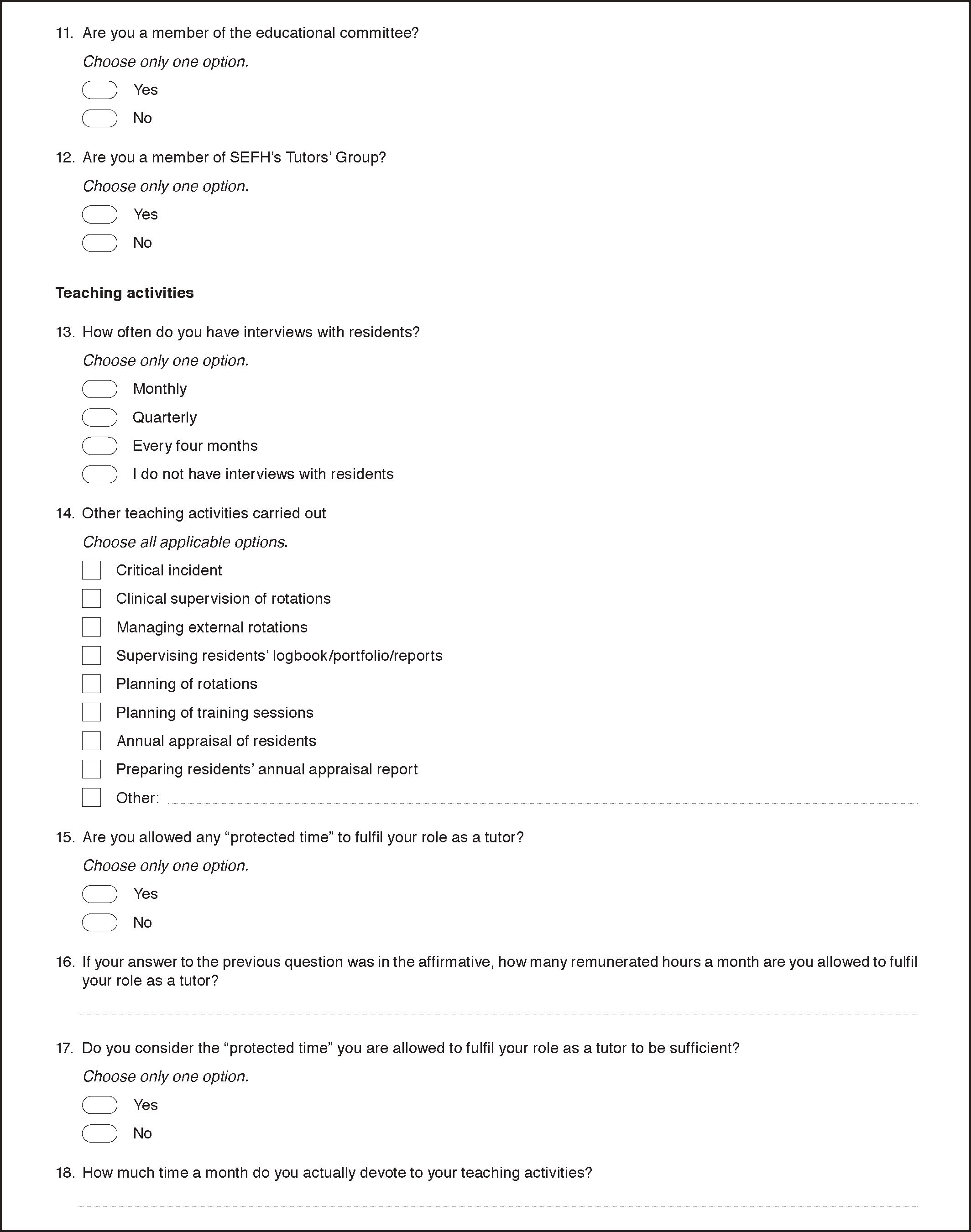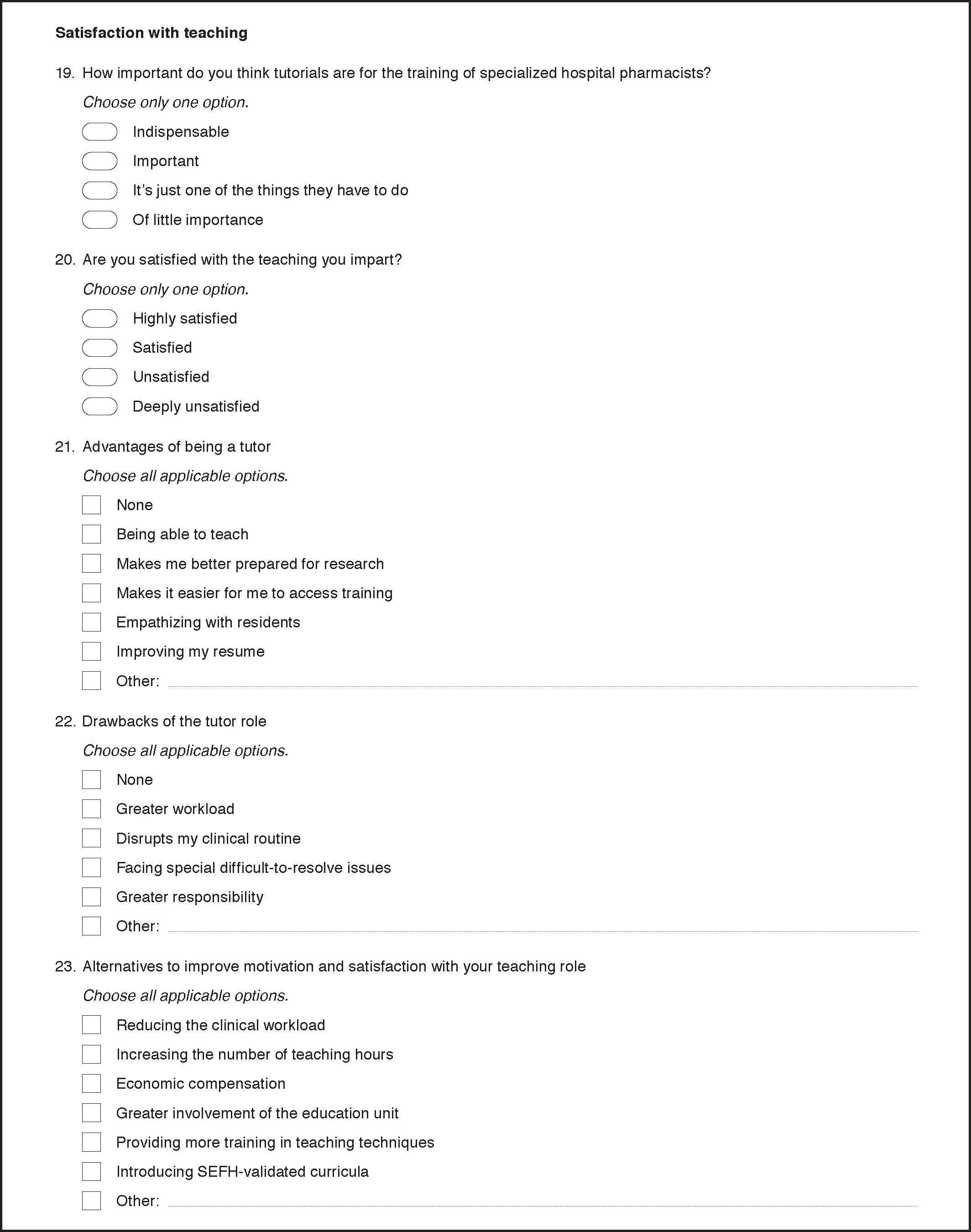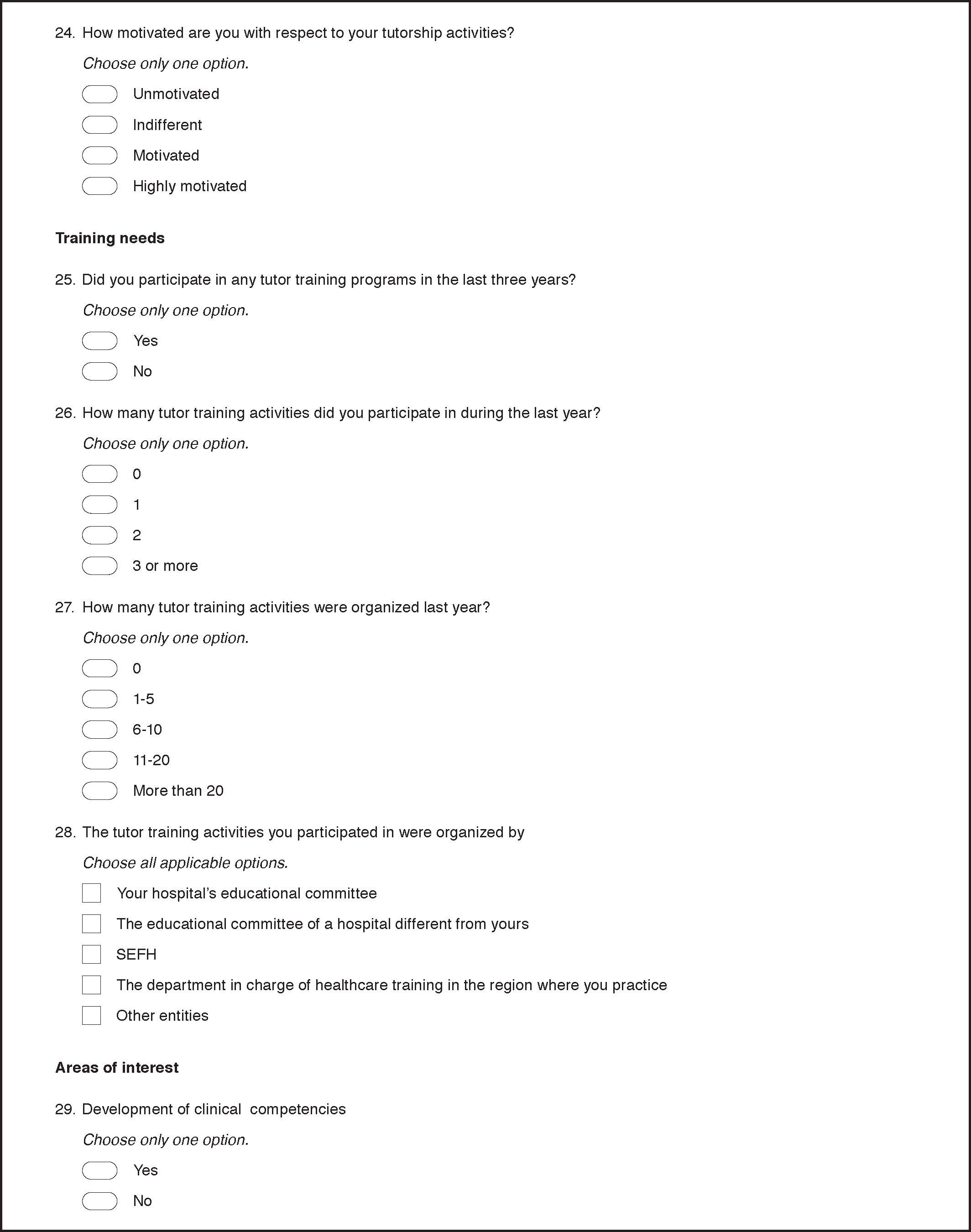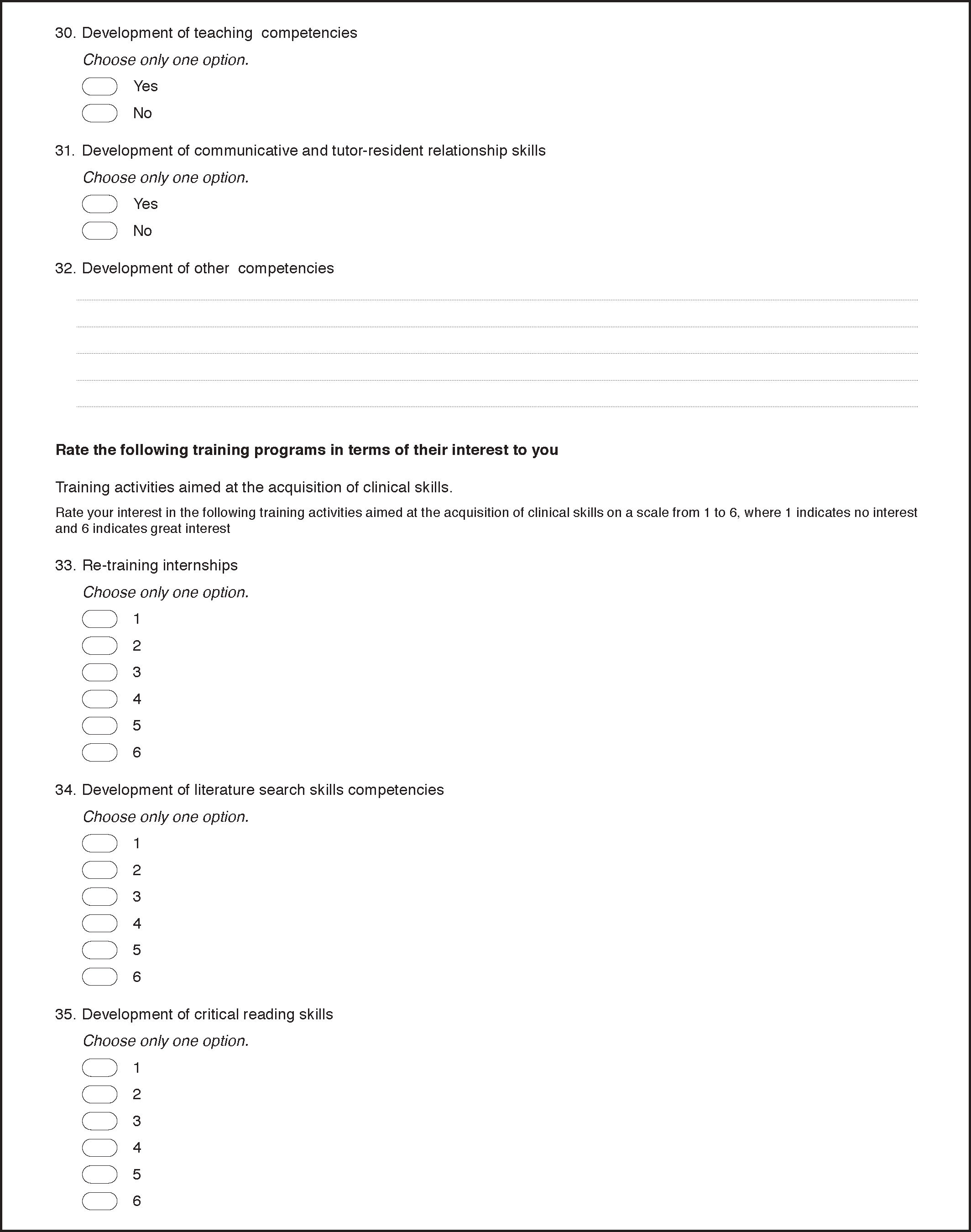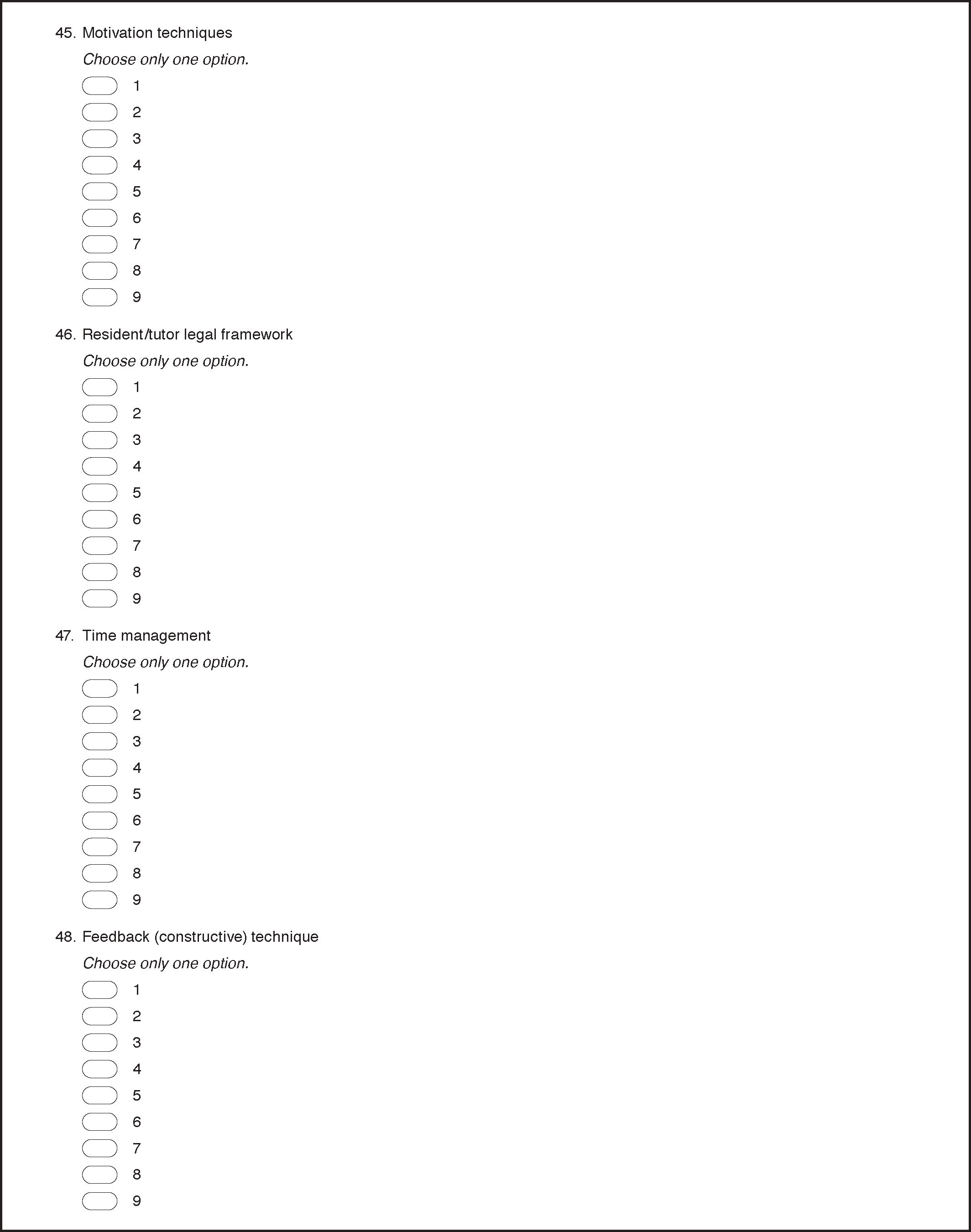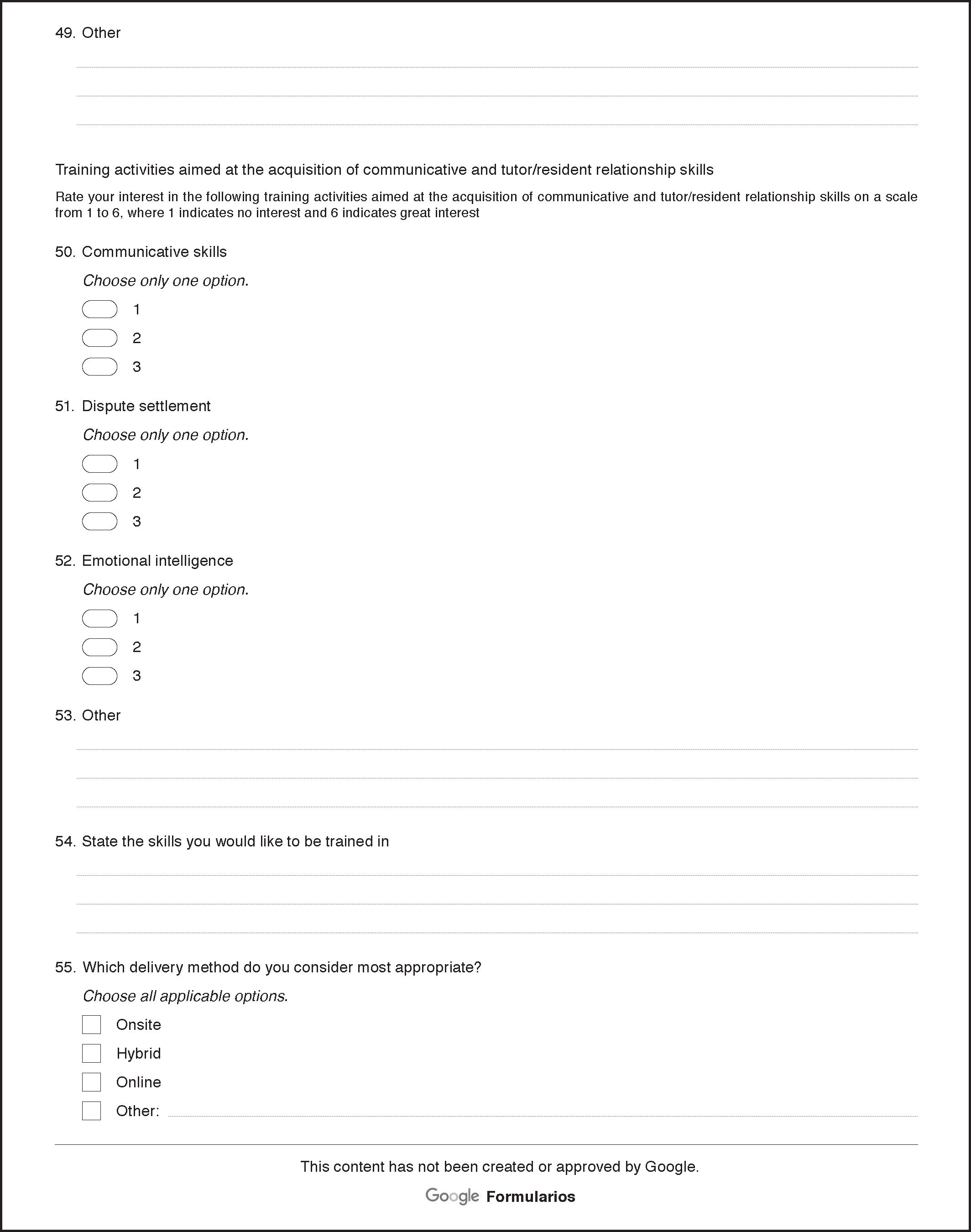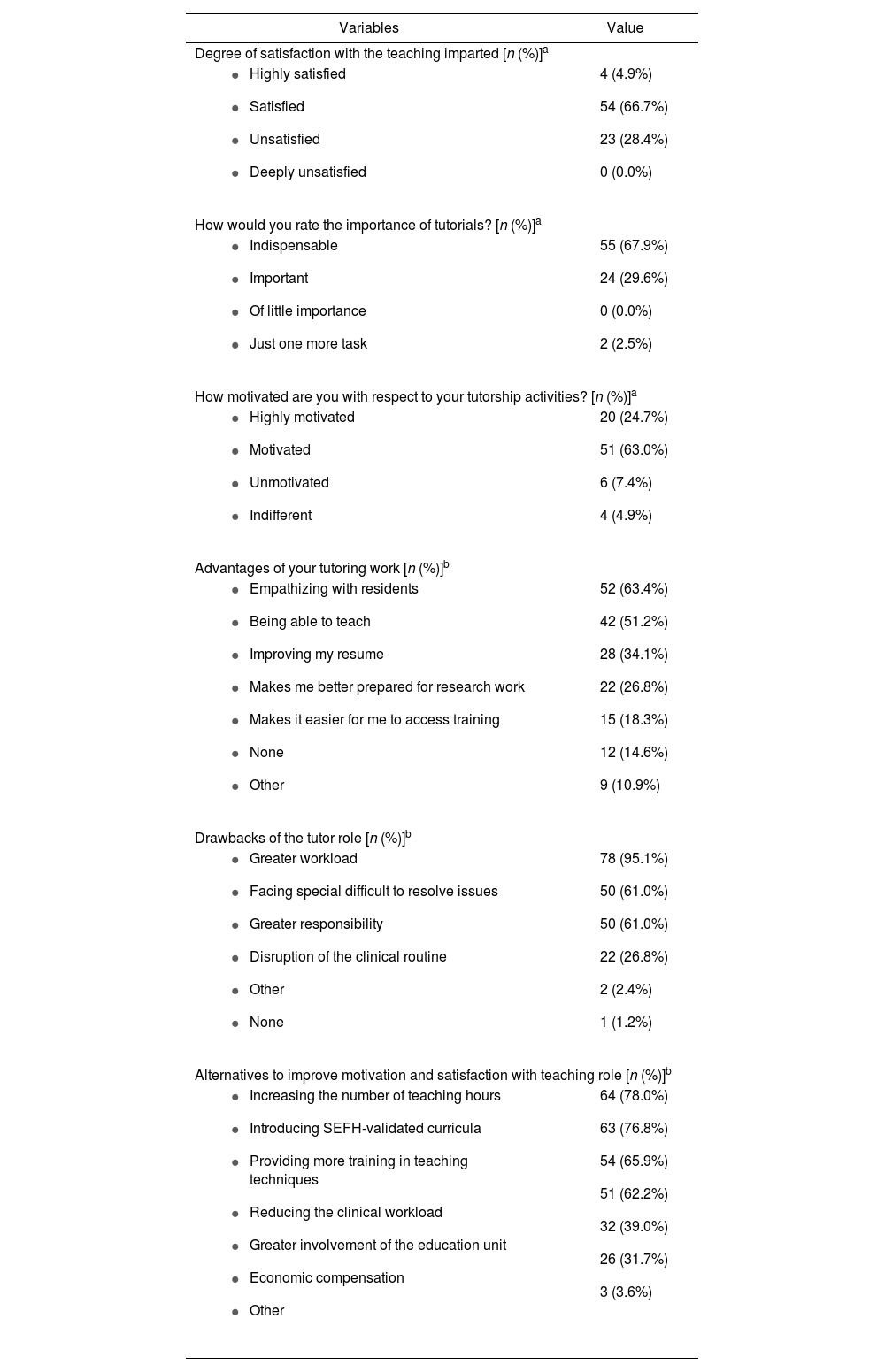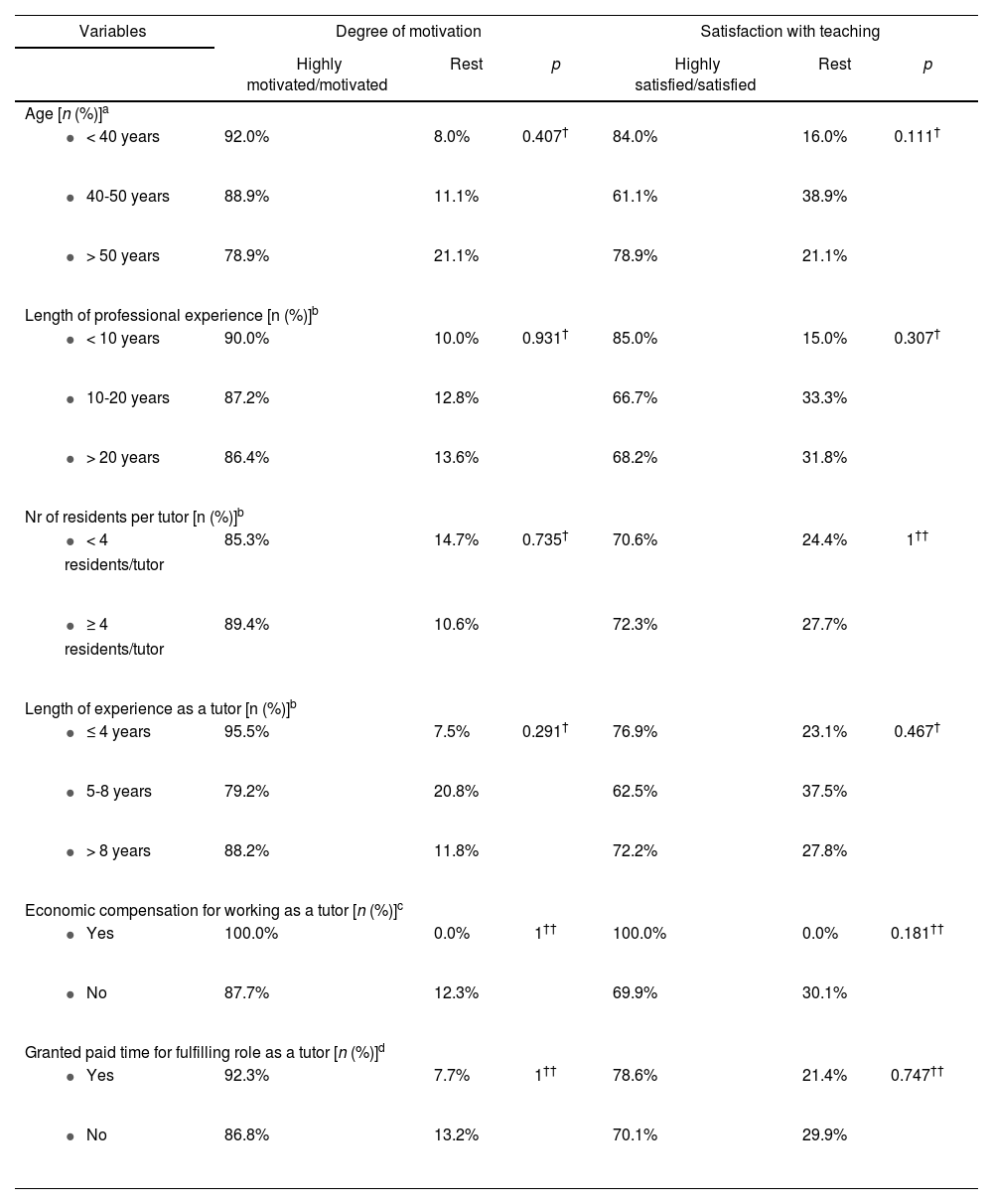To provide new insight into the training needs and resources required by hospital pharmacy resident tutors in Spain, as well as into their level of motivation and satisfaction with their teaching.
MethodGoogle Forms® was used to design a survey addressed to hospital pharmacy resident tutors between January and March 2019. They survey consisted of generic (tutor, hospital, service) and specific questions (available resources, teaching activities, teaching satisfaction, training needs). A univariate exploratory analysis was conducted to study possible factors related to teaching satisfaction and motivation.
ResultsReplies were received from 83 tutors (rate of response: 52.8%), from 15/17 Spanish regions. The annual resident/tutor ratio was 4 (IQR = 2-4). A total of 96.4% of tutors conducted interviews, of whom 65.1% did so quarterly. Other activities included the management of external training rotations (97.6%), planning of rotations (97.6%) and annual appraisals (96.4%). Only 17.1% of respondents were given time off their regular duties for their tutorship work, with 71.4% stating that the time they were allowed was insufficient. A total of 70.7% of tutors from eight Spanish regions where the granting of protected time was regulated said were not given any time off for their teaching endeavors. Most tutors declared to be satisfied (66.7%) and motivated (63%) with their teaching work. Motivation appeared to fall with age, and both motivation and satisfaction decreased as a function of the tutors’ years of professional experience and when they were given no time off for their tutorship work or when the remuneration was low, without any relationship being identified between these factors. Tutors pointed out that work should be done to increase the number of hours assigned to tutorships (78%), preparing SEFH-validated training plans (76.8%), improving teaching techniques (65.9%), and decreasing the clinical workload (62.2%). Over the past 3 years, 69.1% of tutors had received training. This training was arranged by educational committees (63.3%), the Spanish regional authorities (42.4%) and SEFH (13.6%). All the training in clinical, teaching, and communicative competencies enjoyed wide acceptance (> 90%). The preferred delivery method was hybrid (partly on-line and partly onsite) (64.6%).
ConclusionsSEFH's tutors’ group conducted its first national survey addressed to hospital pharmacy resident tutors. The survey showed that, although tutors are highly satisfied with their teaching activities, they would like more training and to be able to devote more time to their tutorship work. It was also shown that a regulatory framework needs to be implemented in various Spanish regions and that compliance with existing regional regulations must be improved.
Conocer las necesidades formativas y de recursos de los tutores de formación especializada de farmacia hospitalaria de España, así como su motivación y satisfacción con la docencia.
MétodoSe realizó, mediante Google-forms®, una encuesta dirigida a tutores de farmacia hospitalaria durante enero-marzo de 2019 con preguntas generales (tutor, hospital, servicio) y específicas (medios disponibles, actividades docentes, satisfacción con la docencia, necesidades formativas). Se realizó un análisis exploratorio univariante para estudiar posibles factores relacionados con la satisfacción y la motivación docente.
ResultadosRespondieron 83 tutores (tasa de respuesta: 52,8%), de 15/17 comunidades autónomas. El número de residentes/año-tutor resultó 4 (rango intercuartílico = 2-4). El 96,4% realizan entrevistas (trimestrales [65,1%]-ninguna [3,6%]. También se ocupan principalmente de la gestión de rotaciones externas [97,6%], planificación de rotaciones [97,6%] y la evaluación anual [96,4%]). El 17,1% dispone de horas para la docencia insuficientes para el 71,4%. Un 70,7% de los tutores de ocho comunidades autónomas con normativa sobre el tiempo de liberación carecen de dicho tiempo. Los tutores se declararon mayoritariamente satisfechos con la docencia (66,7%) y motivados (63,0%). Parece que la motivación desciende con la edad, y que motivación y satisfacción disminuyen con los años como tutor y como especialista, también son menores en ausencia de liberación o retribución económica, sin haberse podido demostrar asociación. Los tutores seleccionaron como acciones de mejora: aumento de dedicación horaria (78%), planes formativos validados por la Sociedad Española de Farmacia Hospitalaria (76,8%), mejorar técnicas pedagógicas (65,9%) y menor carga asistencial (62,2%). En los últimos 3 años el 69,1% recibió formación. La formación fue organizada por la Comisión de Docencia (63,3%), comunidades autónomas (42,4%) y Sociedad Española de Farmacia Hospitalaria (13,6%). La formación propuesta en competencias clínicas, docentes y de comunicación fue ampliamente aceptada (> 90%). El formato docente preferido fue semipresencial (64,6%).
ConclusionesEl Grupo de Tutores de la Sociedad Española de Farmacia Hospitalaria ha realizado la primera encuesta nacional dirigida a tutores de farmacia hospitalaria. La encuesta muestra que, aunque la satisfacción con la actividad docente es elevada, los tutores demandan más tiempo de dedicación y una mayor formación. Además, pone de manifiesto que es preciso desarrollar el marco normativo en varias comunidades autónomas y mejorar el cumplimiento de la normativa autonómica vigente.
The foundations for specialized healthcare education in Spain were laid by Royal Decree 183/2008 (henceforth RD 183/2008), enacted on 8 February 2008, which established a catalog of health science specialties and regulated some aspects of the specialized healthcare education system1. The Royal Decree defined tutors as specialists with the knowledge, skills and attitudes required to fulfil a teaching role, who complete of an accreditation program. Entry into force of RD 183/20081 led to the development of new teaching methods, which have been built into the revised educational programs of different heath science specialties, such as medical oncology (2013)2.
Hospital Pharmacy (HP), however, has had the same curriculum since 19993, which does not reflect the current reality of the specialty or incorporate the most recent teaching methods. In addition, the education available to HP tutors is not specific to their professional profile, as most trainer training programs in healthcare are geared towards medical professionals. This stands in the way of ensuring that prospective hospital pharmacists benefit from the homogeneous and high-quality training programs advocated in RD 183/20081.
Against this background, a working group was brought together in 2016 by the Spanish Society of Hospital Pharmacists (SEFH Spanish acronym), made up of a series of tutors and a residents’ representative. The purpose behind setting up this group, named SEFH Tutors’ Group (hereinafter, GT-SEFH), was to provide tutors with the assistance they required as well as to promote collaboration and the exchange of knowledge and experiences between tutors and other hospital pharmacists involved in training activities. Another goal was to collect initiatives and develop projects aimed at improving the quality of training in HP4. Examples of the work done by the group include the publication of a document evaluating the competence level of residents5 and of a handbook on evaluation tools6, and the creation of a proprietary online platform (DOFIR)7.
Understanding the conditions under which HP resident tutors perform their duties as well as their concerns and requirements is fundamental for the development of initiatives by the GT-SEFH. Multiple surveys have been published on the needs of medical tutors specializing in the areas of family medicine8, internal medicine9, and anesthesiology and resuscitation10, among others. These surveys indicate that specialized education tutors are typically required to take on the responsibility of the residents’ training itinerary without having previously benefited from a systematic training-educational program or an exemption from their clinical duties to be able to fulfil their training function, although the situation may vary across different regions or even different hospitals.
Little has been published about the situation of HP resident tutors in Spain. In 2017 Saura-Llamas et al.11 conducted a survey among specialized education tutors across different specialties in the Balearic Islands in order to identify their training needs. Most of the training gaps detected were related to their competency and their teaching skills. Only one HP resident tutor participated in the survey. In 2002, Valladolid-Walsh et al.12 carried out a survey among HP residents and hospital pharmacists, some but not all of them tutors, in order to analyze the educational standards in HP. However, no studies have been published dealing specifically with the situation of HP resident tutors in Spain to shed some light on their situation and their needs.
The purpose of this study is to gain some insight into the activities carried out by HP resident tutors in Spain as well as to identify their needs in terms of education and resources and their level of motivation and satisfaction with their educational role.
MethodsThe GT-SEFH developed a cross-sectional survey addressed to HP resident tutors. The survey's design and interpretation were based on the recommendations for surveys in healthcare contained in Casas Anguita et al.13. The survey was based on a self-administered online questionnaire prepared by the members of the GT-SEFH and designed using Google Forms® (Annex I). It was accompanied by an introductory text that explained the goals of the study as well as its voluntary and anonymous nature, which was distributed through SEFH's mailing list between January and March 2019, with periodic reminders being sent to addressees.
The survey included 55 questions grouped into five sections: 12 generic questions on tutors, pharmacy departments and hospitals, and 43 specific questions (6 on the educational activities offered, both those included in RD 183/20081 and other specialized educational contents14, 6 on the tutors’ motivation/satisfaction with their teaching functions, and 31 questions on the tutors’ training. The questions on training aspects were founded on the competencies-based model proposed by Saura-Llamas et al.15. The survey included open and closed (yes/no) questions, multiple choice questions and other formats such as Likert and numerical rating scales. Some multiplechoice questions contained an open-ended option.
Results are shown as percentages and number of respondents per question.
A descriptive analysis was carried out of the demographic variables collected. Central tendency and dispersion were calculated for numerical variables, and absolute and relative frequencies were estimated for qualitative variables. An univariate exploratory analysis was performed on the factors potentially related to satisfaction and motivation; the variables selected included age, tutor/resident ratio, years of experience as tutor/specialist, eligibility for paid exemption from clinical duties to fulfil tutor role (chi-squared test2 or Fisher's Exact Test). The level of statistical significance was set at p < 0,05). The SPSSv20 package was used for the statistical analysis.
ResultsEighty-three HP resident tutors responded to the survey, which amounts to 52.8% of all tutors registered with SEFH at that point. Not all respondents answered all the questions.
Generic questionsThe 81 respondents who answered the generic questions of the survey fulfilled their duty in 15 of the 17 Spanish autonomous regions: 19.8% in Madrid, 14.8% in Catalonia, 13.6% in Andalusia, and 7.4% in Galicia and Valencia. HP tutors from the remaining regions accounted for 37% of respondents. Tutors had a mean age of 44 years, with a mean of 14 years’ experience as hospital pharmacists and 5 years’ experience as tutors. The generic tutor information is shown in table 1.
Generic information and educational activities performed by tutors*
| Generic information | |
|---|---|
| Variables | Value |
| Age (mean ± SD)a | 43.9 ± 6.97 |
| 25 (31.25%) |
| 36 (45.00%) |
| 19 (23.75%) |
| Length of professional experience (median)1. | 14 years (IRQ = 9-20) |
| 20 (24.7%) |
| 39 (48.1%) |
| 22 (27.2%) |
| Occupational status [n (%)]b | |
| 42 (50.6%) |
| 28 (33.7%) |
| 7 (8.4%) |
| 4 (4.8%) |
| 2 (2.5%) |
| Hospital educational status [n (%)]b | |
| 78 (94%) |
| 5 (6%) |
| Nr of pharmacists per HP department [n (%)]b | |
| 51 (61.4%) |
| 20 (24.1%) |
| 8 (9.6%) |
| 4 (4.8%) |
| Nr of residents per HP department [n (%)]b | |
| 3 (3.6%) |
| 31 (37.3%) |
| 13 (15.7%) |
| 36 (43.4%) |
| Nr of residents per tutor (median)b | 4 (IRQ = 2-4) |
| 42.0% |
| 58.0% |
| Length of experience as a tutor (median)b | 5 years (IRQ = 2-8) |
| 39 (49.1%) |
| 24 (29.6%) |
| 18 (22.2%) |
| Economic compensation for being a tutor [n (%)]c | |
| 7 (8.5%) |
| 75 (91.5%) |
| Member of the educational committee [n (%)]b | |
| 22 (26.5%) |
| 61 (73.5%) |
| Member of SEFH's tutors' group [n (%)]b | |
| 42 (50.6%) |
| 41 (49.4%) |
| Granted paid time for fulfilling role as a tutor [n (%)]c | |
| 14 (17.1%) |
| 68 (82.9%) |
| Educational activities [n (%)]b | |
| 81 (97.6%) |
| 81 (97.6%) |
| 80 (96.4%) |
| 70 (84.3%) |
| 70 (84.3%) |
| 57 (68.7%) |
| 49 (59.0%) |
| 17 (20.5%) |
| 1 (1.2%) |
HP: Hospital Pharmacy; IRQ: interquartile range; OSCE: objective structured clinical examination; SD: standard deviation; SEFH: Sociedad Española de Farmacia Hospitalaria.
A total of 80 of 83 tutors (96.4%) participated in structured interviews, 65.1% of them every three months, 18.1% every four months and 3.6% every month. Other activities carried out are included in table 1.
When asked whether they were given time off their clinical schedule to fulfil their role as tutors, 17.1% (14/82) answered in the affirmative, with half of these respondents (7/14) being granted ≥ 7 hours/month. A total of 71.4% of these tutors (10/14) considered the time they allowed to be insufficient. As many as 70.7% (29/41) of tutors working in regions where the regulations made explicit reference to the need to exempt healthcare providers from part of their clinical duties to perform educational activities stated that they were not allowed to devote any of their working hours to teaching activities.
Seventy tutors answered the question about the time they effectively devoted to teaching every month. Of them, 54.3% said they devoted ≥ 8 h/month, with the median standing at 8 hours (IQR = 4.75-12.5).
Satisfaction with their teaching tasksA total of 66.7% of tutors were satisfied with the education they provided; with 67.9%. considering their role indispensable. Sixty-three percent declared to be motivated and considered empathizing with residents one of the biggest advantages of their tutoring work whereas the heavy workload they were under was the main drawback. Answers about satisfaction, motivation, the pros and cons of being a tutor, as well as the alternatives suggested by tutors to improve their educational function are shown in table 2.
Satisfaction and motivation with teaching; alternatives to improve tutors' educational role
| Variables | Value |
|---|---|
| Degree of satisfaction with the teaching imparted [n (%)]a | |
|
|
| How would you rate the importance of tutorials? [n (%)]a | |
|
|
| How motivated are you with respect to your tutorship activities? [n (%)]a | |
|
|
| Advantages of your tutoring work [n (%)]b | |
|
|
| Drawbacks of the tutor role [n (%)]b | |
|
|
| Alternatives to improve motivation and satisfaction with teaching role [n (%)]b | |
|
|
Tolal n = 81a, 82b
The univariate analysis showed a connection between degree of motivation and satisfaction with teaching and the different variables analyzed (Table 3), although motivation seems to decrease gradually as respondents become more experienced in their role as tutors and as specialists. Motivation was always lower when respondents lacked time to perform their educational tasks or when they were not paid for them.
Univariate analysis of selected variables related with the tutors' motivation and satisfaction with their teaching role
| Variables | Degree of motivation | Satisfaction with teaching | ||||
|---|---|---|---|---|---|---|
| Highly motivated/motivated | Rest | p | Highly satisfied/satisfied | Rest | p | |
| Age [n (%)]a | ||||||
| 92.0% | 8.0% | 0.407† | 84.0% | 16.0% | 0.111† |
| 88.9% | 11.1% | 61.1% | 38.9% | ||
| 78.9% | 21.1% | 78.9% | 21.1% | ||
| Length of professional experience [n (%)]b | ||||||
| 90.0% | 10.0% | 0.931† | 85.0% | 15.0% | 0.307† |
| 87.2% | 12.8% | 66.7% | 33.3% | ||
| 86.4% | 13.6% | 68.2% | 31.8% | ||
| Nr of residents per tutor [n (%)]b | ||||||
| 85.3% | 14.7% | 0.735† | 70.6% | 24.4% | 1†† |
| 89.4% | 10.6% | 72.3% | 27.7% | ||
| Length of experience as a tutor [n (%)]b | ||||||
| 95.5% | 7.5% | 0.291† | 76.9% | 23.1% | 0.467† |
| 79.2% | 20.8% | 62.5% | 37.5% | ||
| 88.2% | 11.8% | 72.2% | 27.8% | ||
| Economic compensation for working as a tutor [n (%)]c | ||||||
| 100.0% | 0.0% | 1†† | 100.0% | 0.0% | 0.181†† |
| 87.7% | 12.3% | 69.9% | 30.1% | ||
| Granted paid time for fulfilling role as a tutor [n (%)]d | ||||||
| 92.3% | 7.7% | 1†† | 78.6% | 21.4% | 0.747†† |
| 86.8% | 13.2% | 70.1% | 29.9% | ||
Total n = 80a, 83b, 82c, 81d; †Chi squared test2; ††Fisher's Exact Test.
In the last three years, 69.1% (56/81) of tutors participated in educational activities. The number of activities offered to 80 tutors over that period was 0 for 41.3% of tutors; one for 42.5%, and two for 16.2%. The number of training hours over the last year was 0 for 41.5% of tutors, 1-5 for 18.3%: 6-10 for 22.0%; 11-20 for 14.6% and over 20 hours for 3.7%. As regards the organizers of the different training activities, 66 tutors responded that 63.3% of activities had been organized by educational committees, 42.4% by regional health authorities, 13.6% by SEFH and 6.0% by other entities.
With respect to the thematic areas selected, 95.1% (78/82) of tutors chose training in teaching methods, 94.9% (75/79) clinical competencies, and 90.1% (73/81) communicative competencies. The respondents’ preferences regarding the subjects proposed for each competency are shown in figure 1, which reflects the values corresponding to the first tercile of the different scales used to rate the tutors’ preferences regarding each competency. The preferred mode of delivery (82 tutors) was hybrid (64.6%), followed by online (35.4%) and face-to-face (34.1%).
DiscussionThis study reports on the results of the first Spain-wide survey addressed to HP resident tutors with the aim of obtaining real world information on their needs so as to develop suitable educational structures and activities.
The response rate obtained (52.8%) comes across as rather low, especially taking into consideration that the survey was addressed to a specific target group, raised important issues, was anonymous and easily accessible (as it was sent by e-mail), was followed by a series of reminder e-mails and was administered by means of a user-friendly easy-to-use template. There being no national registry for tutors, the survey was sent to all pharmacists on SEFH's mailing list, i.e., it was not sent specifically to tutors. This could be a limiting factor, added to the fact that as recipients usually receive multiple messages from SEFH, getting one more message, which also asked them to devote time to complete a task, could have generated a certain level of annoyance. However, as compared with other similar surveys administered recently in Spain to specialized healthcare education tutors, the response rate stands halfway between the 68.42% achieved among physical medicine tutors16 and the 43.8% achieved among internal medicine tutors9.
The DOFIR7 HP residency educational platform has been equipped with a national HP resident tutor register intended to facilitate communication with that group of professionals. Currently the register contains 182 entries from 108 HP departments accredited for teaching.
The current survey showed that 3.6% of tutors did not carry out structured interviews and 21.7% of those who did, conducted only the legal minimum, set at four interviews per year1. These results indicate that lack of time is one of the factors preventing tutors from carrying out their expected number of interviews. Over 80% of tutors were found to perform all the teaching activities included in the regulations, i.e., management of external rotations, supervision the residents’ logbook/reports/portfolio, planning of rotations, and preparation of residents’ annual evaluation reports. Nonetheless, other, more complex, evaluation instruments such as clinical incident reports and the OSCE (Objective Structured Clinical Examination) are only used by a minority. This variability could be due to the varying extent to which the different Spanish regions have implemented the stipulations of RD 183/2008, which has only been fully enforced in Andalusía17, Catalonia18, the Canary Islands19, Castile-Leon20, Castile-La Mancha21, the Balearic Islands22, Extremadura23, La Rioja24 and the Basque Country25, and to the failure to apply the new curriculum of the specialty which described the type of evaluation tools available and the regularity with which they should be administered. Another important factor is the lack of paid time to carry out educational activities: only 17.1% of respondents was allowed a certain number of hours to perform teaching activities, which were anyway considered insufficient by the majority (91.7%). This factor is closely connected with what, in the opinion of an overwhelming majority of respondents (95.1%), was the main drawback about being a tutor, namely the heavy workload associated with the job. The high number of tutors coming from regions where the legislation requires that hospital pharmacists be exempted from part of their regular duties but who nevertheless get no dispensation at all should lead to a denunciation of the infringement of such rules and to the adoption of measures to rectify the situation. As regards the “heavy workload” denounced by tutors and the infringement of the regulations by some regional authorities, the survey shows that 1.2% of respondents must take care of 6 residents/year, which exceeds the limit of 5 stipulated by RD 183/20081.
However, the tutors’ satisfaction and motivation with their educational activities were high, which contrasts with the results of Valladolid-Walsh et al.12 where 33% of tutors said they would gladly give up their tutorship work. Moreover, most of the respondents in the present study consider the role of the tutor important and indispensable. These findings appear to be related with the “pleasure of conveying knowledge to others,” cited by over 50% of respondents as one of the advantages of being a tutor, which is indicative of a clear vocational component. The first survey launched by GT-SEFH, which was addressed to 4th year HP residents, also brought out the importance of the tutor role26. Although the univariate exploratory analysis in this study only considered the variables that were in principle most closely associated with motivation and satisfaction with teaching, no association whatsoever was found between them. Motivation and satisfaction were very high, regardless of the variables analyzed, and the analysis performed seems to indicate that they only decreased with age, with the years of professional experience as a tutor, when tutors were given no protected time or when their levels of remuneration were low. These results, again, suggest a potential vocational component.
As regards things to be improved, respondents stated that the time allowed for training activities should be extended. As early as in 2002, Valladolid-Walsh et al.12 discovered that pharmacists had little time to devote to their teaching role (92% had less than three hours a week) and suggested that a reorganization be made and that tutors be exempted from more of their clinical work to be able to properly fulfil their role. A comparison with the results obtained from the present survey shows that although the situation has improved in the intervening 17 years, the progress made is not enough. The lack of paid time does not seem to be a problem affecting only the training of hospital pharmacists as it has also come up in surveys administered to internal medicine9, medical oncology27, and anesthesiology and resuscitation10 tutors. Nor is it a problem specific to the Spanish training system. Indeed, in a survey conducted in 2015 among tutors and residents of the American Society of Health-System Pharmacists, Hartzler et al.28 reported that lack of paid time was the main barrier to the development of tutors.
Around 40% of the tutors surveyed had not received any training in the past three years and the percentage of those not receiving training during the last year was the same. As a result, respondents agreed that one of the key aspects to be improved was the time allowed for training. In contrast, in Valladolid-Walsh et al.12 63% of respondents did not consider it necessary to undergo specific training to fulfil their teaching roles. This difference with respect to the present survey may be due to the fact that Valladolid-Walsh et al.’s survey12 was not targeted only to tutors and, in addition, it was administered in 2002, i.e., before the entry into force of RD 183/20081, which elevated the tutors’ profile and increased the complexity and number of their activities. Other specialized education tutors also demand to be trained more comprehensively, as shown by several surveys conducted both in Spain27 and abroad29.
In the absence of a map of the competencies of HP resident tutors, questions on educational contents were founded on a generic professional model based on the competencies of specialized healthcare education tutors15. Availability of a specific competencies map is important as it specifies all the knowledge, skills and attitudes needed by tutors to correctly perform their work and is fundamental for their accreditation and training, thus contributing to excellence on the job. Drawing up a competencies-based map for HP tutors will be one of the priorities for GT-SEFH in the future.
The present study has shown the great interest of HP tutors in receiving the training they need on teaching methods and clinical and communicative competencies. The specific elements respondents stated as necessary to further their knowledge of such competencies, as well as the order in which such elements should be imparted and the delivery method to be used (hybrid) were in line with those found in other surveys among HP tutors. For example, in 2012 Truong et al.29 published the results of a survey where Canadian HP tutors were asked to spell out their needs, with a majority of them denouncing a lack of training. The areas where they felt more emphasis should be made, i.e., constructive feedback and practical evaluation strategies, were in line with those invoked by tutors in the present survey.
Only 50% of tutors responding to the survey were members of the GT-SEFH. This seems to indicate that a high number of tutors fulfil their role without the need to be backed by a professional network, which appears to contradict the findings of the survey in terms of the shortcomings and flaws identified in the present survey. The purpose of the GT-SEFH being precisely that of helping tutors, it is of the essence to increase its membership. The development of future projects for HP tutors based on the findings presented here could help achieve that goal.
One of the limitations of this study is that, although the questions asked were previously reviewed by the members of the GT-SEFH, the survey as such was not fully validated. Moreover, although the response rate (52.8%) was too low to take the results at face value, the broad representation obtained (tutors from 78.9% of Spanish regions sent in their answers) provides our findings with a measure of robustness. Finally, a certain selection bias may have existed (the survey was voluntary and could have attracted only particularly motivated tutors), which makes it difficult to generalize the results obtained.
This first Spain-wide survey of HP resident tutors provides, apart from a deeper understanding of the current profile of HP resident tutors, information about their activities, difficulties and needs. Although satisfaction with their educational activities is high, tutors demand to be allowed more time for these activities and to be provided with better training. Lastly, the survey emphasizes the need to develop a regulatory framework in several of the country's regions and improve compliance with the existing regulations.
FundingNo funding.
AcknowledgementsThe authors would like to thank Elia Pérez Fernández from the Research Unit at Fundacion Alcorcón University Hospital for her help with the statistical analysis.
Presentation at congresses64th National Congress Sociedad Española de Farmacia Hospitalaria. Sevilla: 17-19 October 2019.
Conflict of interestNo conflict of interests.
Contribution to the scientific literature
The present study reflects the results of the first Spain-wide survey of hospital pharmacy resident tutors and provides hitherto unknown data about the tutors’ profile, their activities, difficulties and needs. This information with no doubt be useful to improve the quality of their tutorship work.ANNEX 1. SEFH tutors’ group survey on specialized pharmaceutical training
- •
Eva Negro Vega,
Hospital Universitario de Getafe, Madrid.
- •
Teresa Giménez Poderos,
Hospital Universitario Marqués de Valdecilla, Santander.
- •
Raquel Arrieta Navarro,
Hospital Miguel Servet, Zaragoza.
- •
Edurne Fernández de Gamarra Martínez,
Hospital de la Sta. Creu i St. Pau, Barcelona.
- •
M.a José Gimeno Jorda,
Hospital de Poniente, El Ejido-Almería.
- •
Patricia Sanmartín Fenollera,
Hospital Universitario Fundación Alcorcón, Madrid.
- •
M.a Amparo Talens Bolos,
Hospital Sant Joan, Alicante.
- •
M.a Dolores Zamora Barrios,
Hospital Clínico San Carlos, Madrid.
- •
Covadonga Pérez Menéndez-Conde,
Hospital Ramón y Cajal, Madrid.
- •
Joan Vinent Genestar,
Hospital San Joan de Deu, Barcelona.
- •
Adrián Repilado Álvarez,
Hospital Universitario Puerta Hierro-Majadahonda, Madrid.
Early Access date (10/08/2021).




